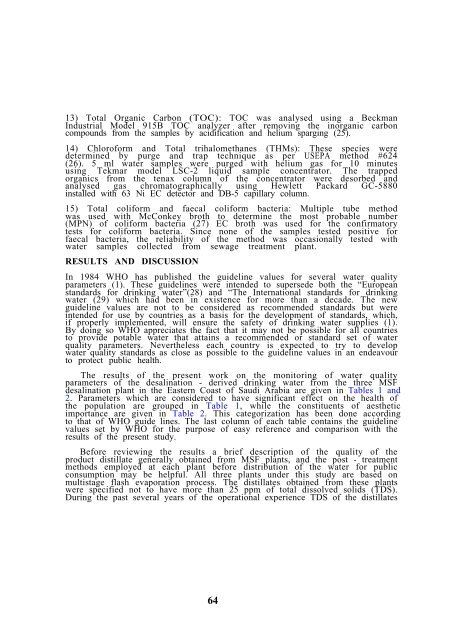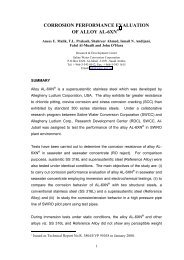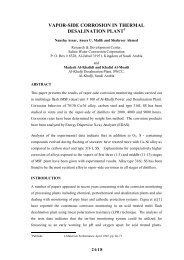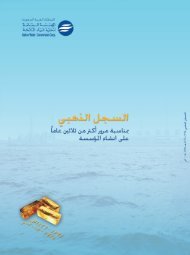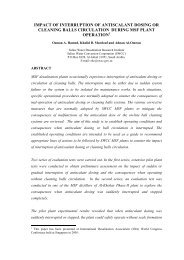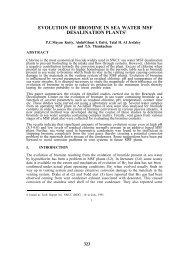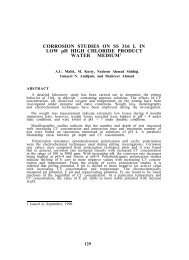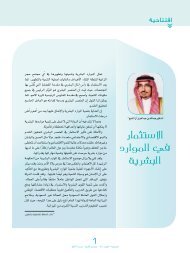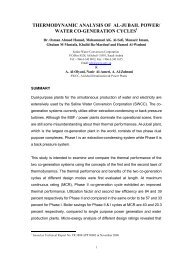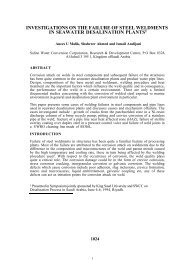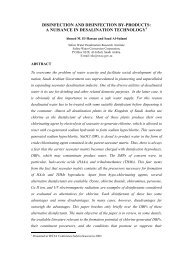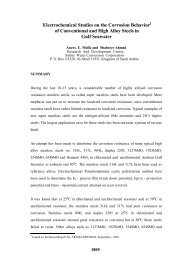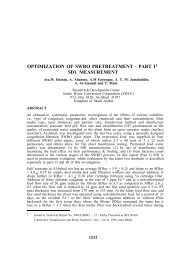quality control of potable water supplies from swcc's
quality control of potable water supplies from swcc's
quality control of potable water supplies from swcc's
You also want an ePaper? Increase the reach of your titles
YUMPU automatically turns print PDFs into web optimized ePapers that Google loves.
13) Total Organic Carbon (TOC): TOC was analysed using a Beckman<br />
Industrial Model 915B TOC analyzer after removing the inorganic carbon<br />
compounds <strong>from</strong> the samples by acidification and helium sparging (25).<br />
14) Chlor<strong>of</strong>orm and Total trihalomethanes (THMs): These species were<br />
determined by purge and trap technique as per USEPA method #624<br />
(26). 5 ml <strong>water</strong> samples were purged with helium gas for 10 minutes<br />
using Tekmar model LSC-2 liquid sample concentrator. The trapped<br />
organics <strong>from</strong> the tenax column <strong>of</strong> the concentrator were desorbed and<br />
analysed gas chromatographically using Hewlett Packard GC-5880<br />
installed with 63 Ni EC detector and DB-5 capillary column.<br />
15) Total coliform and faecal coliform bacteria: Multiple tube method<br />
was used with McConkey broth to determine the most probable number<br />
(MPN) <strong>of</strong> coliform bacteria (27) EC broth was used for the confirmatory<br />
tests for coliform bacteria. Since none <strong>of</strong> the samples tested positive for<br />
faecal bacteria, the reliability <strong>of</strong> the method was occasionally tested with<br />
<strong>water</strong> samples collected <strong>from</strong> sewage treatment plant.<br />
RESULTS AND DISCUSSION<br />
In 1984 WHO has published the guideline values for several <strong>water</strong> <strong>quality</strong><br />
parameters (1). These guidelines were intended to supersede both the “European<br />
standards for drinking <strong>water</strong>”(28) and “The International standards for drinking<br />
<strong>water</strong> (29) which had been in existence for more than a decade. The new<br />
guideline values are not to be considered as recommended standards but were<br />
intended for use by countries as a basis for the development <strong>of</strong> standards, which,<br />
if properly implemented, will ensure the safety <strong>of</strong> drinking <strong>water</strong> <strong>supplies</strong> (1).<br />
By doing so WHO appreciates the fact that it may not be possible for all countries<br />
to provide <strong>potable</strong> <strong>water</strong> that attains a recommended or standard set <strong>of</strong> <strong>water</strong><br />
<strong>quality</strong> parameters. Nevertheless each country is expected to try to develop<br />
<strong>water</strong> <strong>quality</strong> standards as close as possible to the guideline values in an endeavour<br />
to protect public health.<br />
The results <strong>of</strong> the present work on the monitoring <strong>of</strong> <strong>water</strong> <strong>quality</strong><br />
parameters <strong>of</strong> the desalination - derived drinking <strong>water</strong> <strong>from</strong> the three MSF<br />
desalination plant in the Eastern Coast <strong>of</strong> Saudi Arabia are given in Tables 1 and<br />
2. Parameters which are considered to have significant effect on the health <strong>of</strong><br />
the population are grouped in Table 1, while the constituents <strong>of</strong> aesthetic<br />
importance are given in Table 2. This categorization has been done according<br />
to that <strong>of</strong> WHO guide lines. The last column <strong>of</strong> each table contains the guideline<br />
values set by WHO for the purpose <strong>of</strong> easy reference and comparison with the<br />
results <strong>of</strong> the present study.<br />
Before reviewing the results a brief description <strong>of</strong> the <strong>quality</strong> <strong>of</strong> the<br />
product distillate generally obtained <strong>from</strong> MSF plants, and the post - treatment<br />
methods employed at each plant before distribution <strong>of</strong> the <strong>water</strong> for public<br />
consumption may be helpful. All three plants under this study are based on<br />
multistage flash evaporation process. The distillates obtained <strong>from</strong> these plants<br />
were specified not to have more than 25 ppm <strong>of</strong> total dissolved solids (TDS).<br />
During the past several years <strong>of</strong> the operational experience TDS <strong>of</strong> the distillates<br />
64


